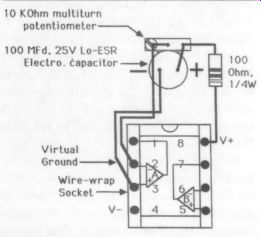CAPACITORLESS CD output
On a much-modified Magnavox CDB 472 CD player, I had given the output decoupling capacitor much upgrading attention. It had become an elaborate combination of polypropylene and polystyrene capacitors, with definite sonic improvements, but I was considering ways to eliminate it. In "Letters" (TAA 1/90, p. 56), Mr. Kong C. Ng expressed the belief that the output caps were sources of degradation and should be removed. This preyed on my mind.
In most Magnavox-based players, the output decoupling capacitor blocks a positive DC bias voltage originating at the D/A stage. Therefore, any correcting circuit would apply a "negating" signal to correct this bias.
Nulling Circuitry
Ultimately, I chose to apply John Allgaier's offset nulling circuitry ("14 Bit Magnavox Update," TAA 4/89, p. 8) with DC-coupled output, but with out any servo. My preamp has an input capacitor, so a potential "click" while switching to the CD player seemed a small price to pay for the expected sonic improvement.

FIGURE 1: Magnavox dual opamp offset voltage-nulling circuit (after J.
Allgaier). Notes: 1.) top-view, looking down; 2.) bond cap to pot with silicon;
3.) insulate leads with Teflon sleeve.
Using the parts layout shown in Fig. 1, I carefully soldered the voltage-sensing and output leads onto the indicated legs of each wire-wrap socket used to elevate my opamp /buffer "breakout boards." Upon powering up, | nulled the DC voltages across the out put caps by adjusting the pots.
Switching off, I cut the output capacitor leads close to the board and jumpered the board ends together.
Finally, again under power, I completely nulled the residual offset voltages at the player's output jacks.
Sonic Pleasure
The sonic result of eliminating the output caps and attendant wiring is quite a surprise. Deeper, clearer bass, cleaner highs, much more three dimensionality, and greater "space" appeared. Previously difficult CDs "fell into place" and lost their sonic faults. Harmonic overtones appeared where none were evident before.
There remain none of the supposed deficiencies of CDs versus records, such as low-level detail, ambience, and so on.
The circuit driving the CD output in this instance is not an opamp, but the "0002 buffer" presented by Walt Jung in TAA 2/88 ("Philips/Magnavox CD Player Mods, Part II," p. 19). This buffer can deliver upwards of 0.1A in the MHz range, so it was driving the output cap as well as anything could.
Loading this buffer with just the cabling and preamp input circuit produces extremely clean sound.
I recommend making this enhancement where appropriate to any CD player. Figure 1 assumes that section A of the dual op amp is the current/voltage converter.
For other players with a positive output bias voltage, connect the 100 ohmresistor to the +15V DC supply, the negative lead of the capacitor to ground, and the potentiometer lead to the appropriate summing-point pin (negative input) of your opamp.
Finally, the expected "click" during selector switching is non-existent, even after hours of operation.
--Darcy Staggs Orange, CA
TAMING CD STRIDENCY
One thing I have found useful in taming CD "stridency" is to change the output coupling caps. I know this is not a new idea, but I found that most high-resolution capacitors such as polypropylene, polystyrene, MIT caps, and others improve detail at the expense of allowing more harshness into the audio chain.
While experimenting with oil and oil and paper caps in other applications, I found they sounded somewhat over damped, subtracting some subtle details. This turns out to be a plus, how ever, when you're using them as CD coupling caps. I found that on CD players, as well as on my Audio Alchemy XDP D/A converter, the oil caps reduce the subjective impression of ringing and harshness, lending instead to CD sound a smooth sweetness that is other wise lacking. I found oil and paper caps of 0.1uF value and oil-filled caps of 2-4 uF to be very useful (though some what bulky). If you try this mod, please let me know your findings.
Richard Painter; Ubly, MI.
--------
Also see: